There are five royal palaces that were constructed during the Joseon Dynasty (1392–1897) within walking distance of one another in central Seoul. They include Gyeongbok Palace, the first to be built, and all of them bear witness to the tumultuous history of Joseon, each with a distinct historical background and purpose.
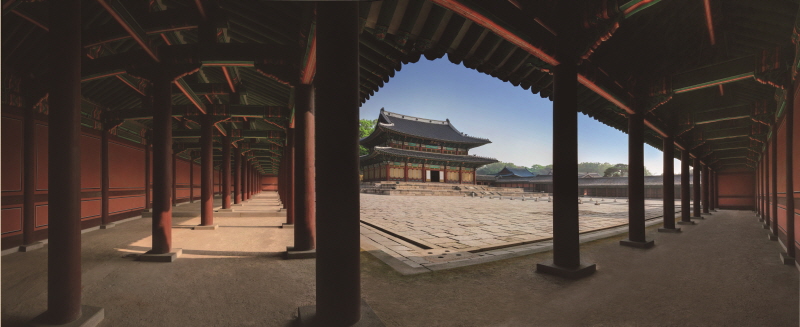
Injeongjeon (the throne hall), the main building of Changdeok Palace, is where many state events were held, including the king’s coronation ceremony. Although from the outside, the building appears to have two floors, it actually only has one, with a magnificent, high ceiling. The courtyard in front is surrounded by a long corridor.
© National Palace Museum of Korea
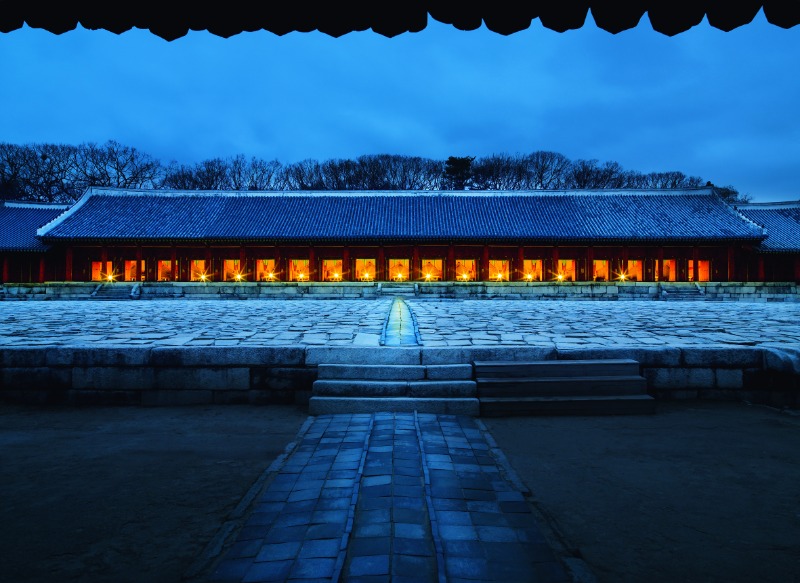
Jongmyo, the royal Confucian shrine housing the spirit tablets of Joseon kings and queens. In 1995, the shrine was designated a UNESCO World Heritage Site. Jongmyo’s elongated building has a simple structure and is devoid of any embellishments or brightly colored decorative paintings in keeping with the solemn atmosphere.
© Seo Heun-kang
While palaces across East Asia were built on a specific model and hence share many similarities, they also have distinct features depending on the region and era. The dynasties that came into power on the Korean peninsula built palaces in their own unique way, with each palace serving as the seat of government.
The question of why there are so many Joseon-era royal palaces is a common one. The simplest answer is the long history of Joseon, a single dynasty that spanned five hundred years. Marked by a number of turbulent events, such as chaos surrounding the succession to the throne, foreign invasions, and wars, its long history would have necessitated the construction of more than one palace.
Rise and Fall
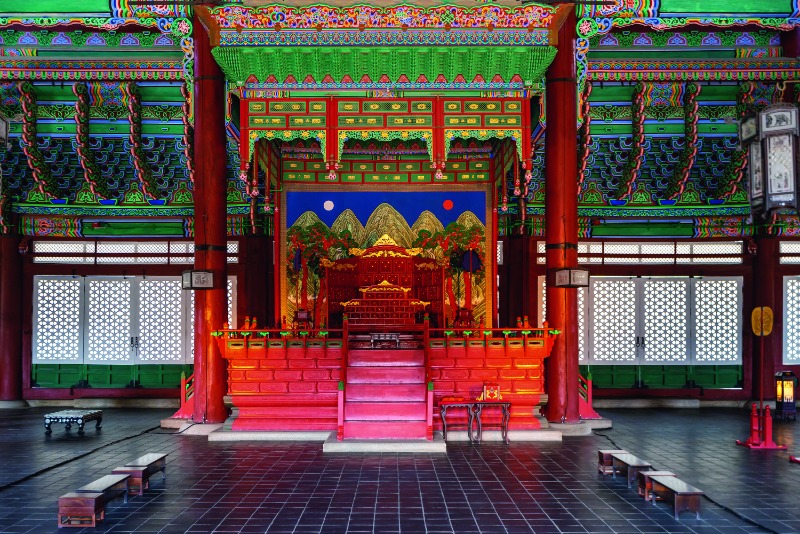
The royal throne inside Gyeongbok Palace’s Geunjeongjeon (throne hall). The hall was elaborately decorated and built on a two-tiered stone platform so as to represent the king’s dignity and authority. Behind it is a folding screen with the sun, moon, and five peaks which symbolize the king.
© Shutterstock
The Joseon royal palaces that still remain today date from different periods. While Gyeongbok Palace was built right after the founding of Joseon, and Changdeok Palace just 10 years later, Changgyeong Palace was built at the end of the 15th century. Gyeonghui Palace was constructed in the early 17th century, and Deoksu Palace was used as the king’s official residence at the end of the 19th century. In addition to these, many other separate palaces also existed.
Historically, two or three palaces existed simultaneously during the Joseon period and were used selectively. During the early part of the dynasty, there were Gyeongbok, Changdeok, and Changgyeong palaces; after all the capital’s palaces were burned down during the Japanese invasions of Korea (1592–1598), the restored Changdeok and Changgyeong palaces and the newly constructed Gyeonghui Palace were used concurrently. When Gyeongbok Palace was rebuilt in the mid-to-late 19th century, Gyeonghui Palace lost its function as a royal residence, and later Gyeongbok Palace itself also fell out of use after the completion of Deoksu Palace.
Having multiple palaces is useful, particularly during a time of emergency or crisis, such as a large fire or epidemic. The rise and fall of Joseon’s five royal palaces were intricately intertwined with the nation’s history, and they remain today as valuable cultural heritage. Gyeongbok, Changdeok, and Changgyeong palaces are located in the center of Jongno, the district north of Cheonggye Stream, which flows through the center of Seoul from east to west. Gyeonghui and Deoksu palaces are located towards the west and south of the city, respectively.
The First Royal Palace
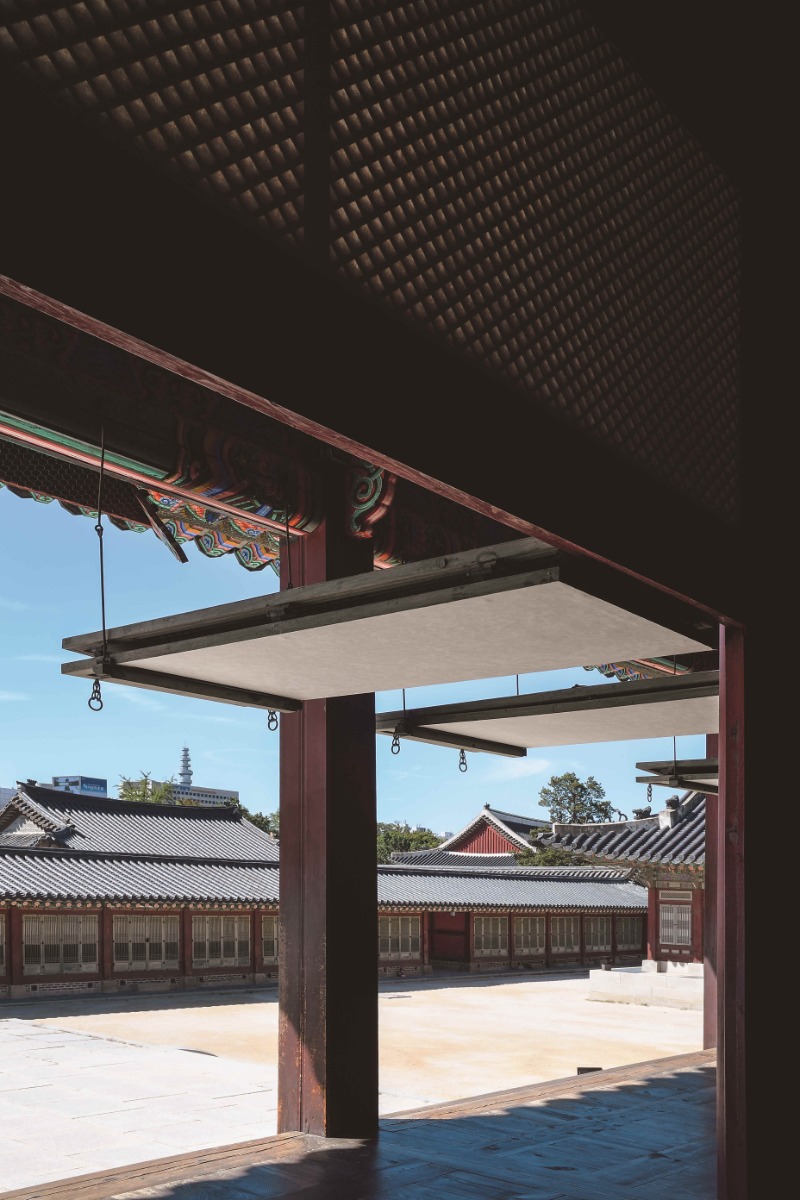
Gangnyeongjeon, the king’s residence in Gyeongbok Palace. Lattice doors, installed between the woodfloored hall and the wooden porch, opened by being lifted up.
© National Palace Museum of Korea
Gyeongbok Palace was completed in 1395, three years after the Joseon Dynasty was founded. Its founder King Taejo (r. 1392–1398) chose Hanyang (the former name of Seoul) as the new capital and built Jongmyo, the royal ancestral shrine, and Gyeongbok Palace, as well as walls around the city, as befitting the capital of a Confucian state.
Gyeongbok Palace stands on relatively flat land that stretches long from north to south. A key feature of its layout is the north–south axis, which runs from its main south gate, Gwanghwamun, through the main buildings Geunjeong jeon (the throne hall), Gangnyeongjeon (the king’s quarters), and Gyotaejeon (the queen’s quarters) to the rear garden Amisan and Hyangwon Pavilion. This is a standard layout commonly found in ancient East Asian countries. The same axis also runs through the city, connecting the government office district in front of the palace and the city’s south gate, Sungnyemun, as well as the imposing mountain peaks in the north.
As the official palace of Joseon, Gyeongbok Palace was refurbished during the reign of King Sejong (r. 1418–1450) as the venue for state ceremonies. It was then burned to the ground when Japan invaded Korea in 1592 and not restored until three centuries later. The palace’s reconstruction began in 1865 and was completed two years later. The following year, King Gojong (r. 1863–1907) moved his residence from Changdeok Palace to Gyeongbok Palace.
In 1895, however, the queen was assassinated by foreign invaders and Gyeongbok Palace lost its status as a royal palace. Thereafter, many of its structures were destroyed during the Japanese occupation. Restoration work is still ongoing and the palace as observed today represents only a part of its original form.
The Longest Existing Palace
Changdeok Palace was built in 1405, initially as a detached palace from Gyeongbok Palace. It is unclear why a second palace on a smaller scale was necessary when Gyeongbok Palace already served as the royal residence. Perhaps King Taejong (r. 1400–1418) wished to avoid Gyeongbok Palace, where he had fought his brothers for the throne, or perhaps it was because his father, Taejo, who had abdicated, was still alive. In any case, the establishment of Changdeok Palace marked the beginning of multiple palaces for the Joseon royal family.
The site of Changdeok Palace is not significant in size. Its position adjacent to the foot of a mountain to the north and the urban area to the south made it impossible to cover a large plot of land. Moreover, the steep incline of the land was not conducive to a neat layout such as that seen at Gyeongbok Palace. That is why, after passing through the main gate, Donhwamun, one has to make several turns in order to reach the palace’s inner quarters. Though the palace structures and yard are smaller than those at Gyeongbok Palace, the site still was not large enough to accommodate a sufficient number of buildings. Instead, an extensive garden was built on the northern hill on palace grounds, which remains to this day as one of the most outstanding royal gardens of Joseon.
Except for a short time during the Imjin War, Changdeok Palace endured for a long period, serving as residence to the largest number of kings. It took over the role of official palace from Gyeongbok Palace, which had yet to be restored, and served in that capacity until the final days of the Joseon Dynasty. Changdeok Palace is regarded as the most iconic example of Joseon palace architecture for its layout and landscape design, and in 1997 it was designated a UNESCO World Heritage site.
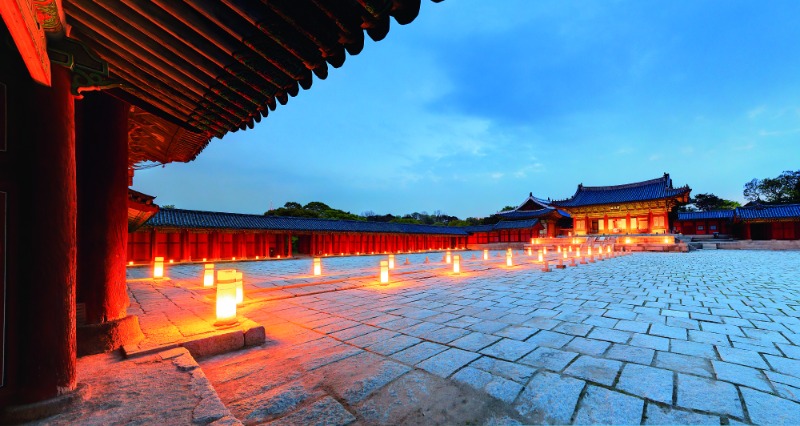
Myeongjeongjeon (the throne hall) in Changgyeong Palace is smaller than the main halls of Gyeongbok and Changdeok palaces but has similarities in its architectural design. All three main halls were destroyed by fire and rebuilt several times, but Myeongjeongjeon has the longest history among them.
© Cultural Heritage Administration
Palace with a Tumultuous History
Changgyeong Palace was completed in 1483 during the reign of King Seongjong (r. 1469–1494). Being too small to accommodate the king’s three dowager queens, it was enlarged, with the central area comprising the queens’ living quarters. A separate building was constructed for the king to reside in and conduct state affairs, as well as serving as the crown prince’s residence. King Jeongjo (r. 1776-1800) lived in the palace and, across from it, built a shrine to his father, Crown Prince Sado, who had died a tragic death. The king visited the shrine frequently.
To the south of Changgyeong Palace lies Jongmyo, the royal Confucian shrine housing the spirit tablets of Joseon kings and queens. Hence, the palace’s main gate had to be placed in the east, rather than the south as was the custom. The palace site is characterized by a gently descending slope in the southeast and a hill in the west. Changgyeong and Changdeok palaces were connected to each other from east to west and were used as one complex. The two were collectively referred to as the “Eastern Palace,” as they were located to the east of Gyeongbok Palace. With the exception of a few important buildings that face east, most of the structures in Changgyeong Palace face south. The building where state affairs were conducted was located on the east side, while the living quarters were on the west, an unusual layout for a Korean palace.
During the Japanese occupation, a zoo and botanical garden were built on the grounds of Changgyeong Palace. The zoo has since been relocated, but the botanical garden’s glass conservatory still stands in the rear garden. The original appearance of Changdeok and Changgyeong palaces before they were damaged is well preserved in “Painting of the Eastern Palace” (Donggwoldo). The almost six-meter wide color painting gives a bird’s-eye view of the buildings and landscape of the two palaces in realistic detail. The original appearance of Gyeonghui Palace, which has the fewest buildings remaining today, can be found in “Plan of the Western Palace” (Seogwoldoan). All bearing witness to the nation’s rich history, the royal palaces of Joseon welcome visitors to this day.